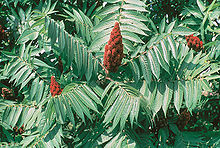Rhus typhina
| Rhus typhina | |
|---|---|
 |
|
| Scientific classification | |
| Kingdom: | Plantae |
| (unranked): | Angiosperms |
| (unranked): | Eudicots |
| (unranked): | Rosids |
| Order: | Sapindales |
| Family: | Anacardiaceae |
| Genus: | Rhus |
| Species: | R. typhina |
| Binomial name | |
|
Rhus typhina L. |
|
 |
|
Rhus typhina syn. R. hirta, the staghorn sumac is a species of flowering plant in the family Anacardiaceae, native to eastern North America. It is primarily found in southeastern Canada, the northeastern and midwestern United States and the Appalachian Mountains, but is widely cultivated as an ornamental throughout the temperate world.
The specific epithet typhina is explained in Linnaeus's and Ericus Torner's description of the plant with the phrase "Ramis hirtis uti typhi cervini" meaning "the branches are rough like antlers in velvet".
Rhus typhina is a deciduous shrub or small tree growing to 5 m (16 ft) tall by 6 m (20 ft) broad. It has alternate, pinnately compound leaves 25–55 cm (10–22 in) long, each with 9–31 serrate leaflets 6–11 cm long. The leaf petioles and the stems are densely covered in rust-colored hairs. The velvety texture and the forking pattern of the branches, reminiscent of antlers, have led to the common name "stag's horn sumach".
Staghorn sumac is dioecious, and large clumps can form with either male or female plants. The fruit is one of the most identifiable characteristics, forming dense clusters of small red drupes at the terminal end of the branches; the clusters are conic, 10–20 cm (4–8 in) long and 4–6 cm (2–2 in) broad at the base. The plant flowers from May to July and fruit ripens from June to September. The foliage turns to brilliant shades of red, orange and yellow in autumn. The fruit has been known to last through winter and into spring.
Staghorn sumac spreads by seeds, and by rhizomes to form colonies, with the oldest plants in the center, and the younger plants radiating out. It grows quite aggressively.
Staghorn sumac is not closely related to poison sumac (Toxicodendron vernix), despite the common name.
...
Wikipedia
